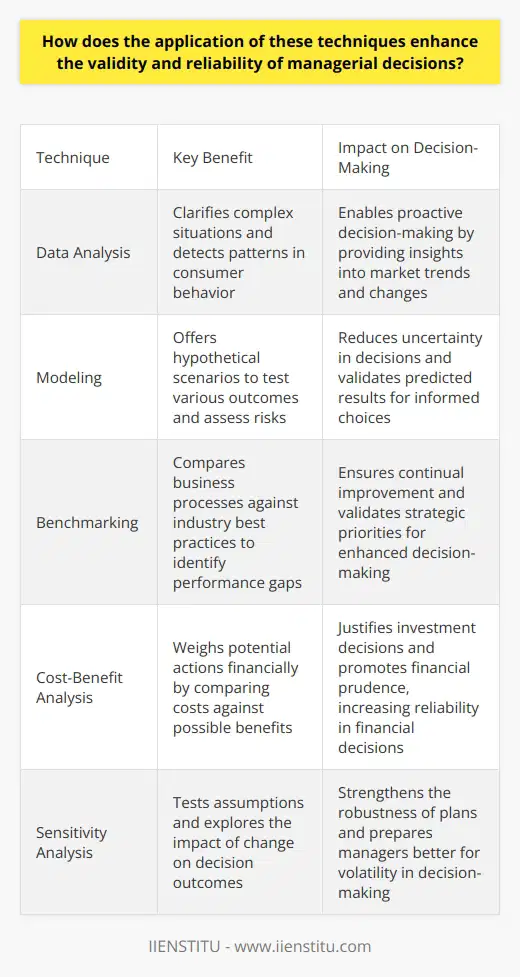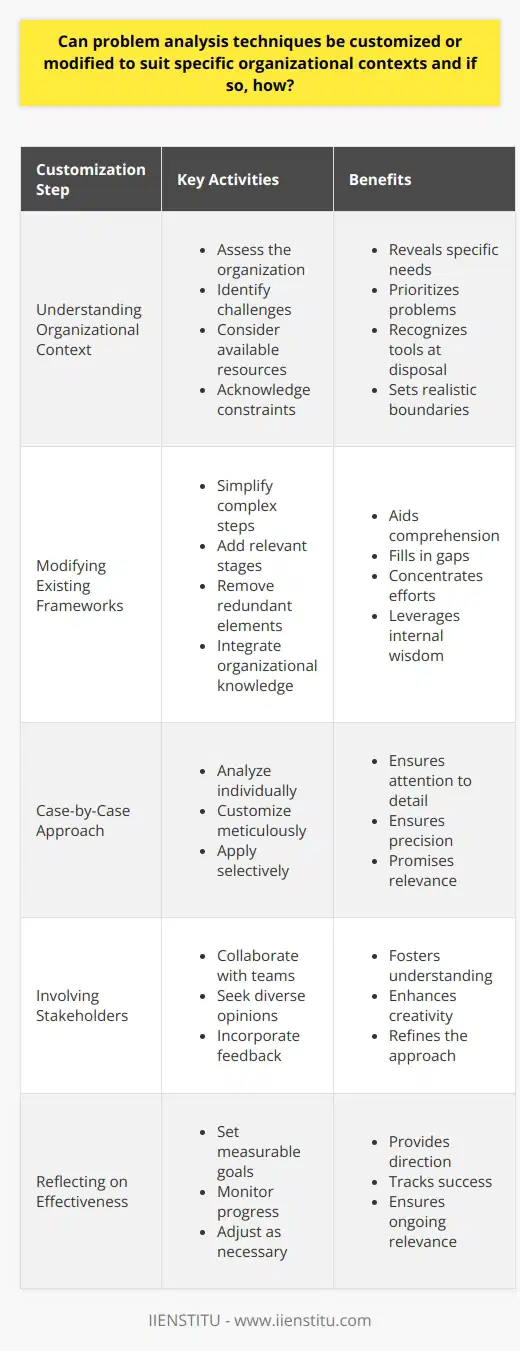
The multifaceted nature of issues within the professional domain necessitates a comprehensive understanding of problem analysis, a skill set increasingly recognized as pivotal in crafting effective solutions. This foundational approach offers a structured pathway to dissect complex situations, enabling a thorough assessment that aids decision-makers across industries.
As we delve into the realm of problem analysis, we shall explore its significance within different contexts, exemplifying its value in enhancing strategic outcomes. Whether employed within a problem solving course or utilized in a business setting, problem analysis stands out as a cornerstone of successful operational management.
Understanding Problem Analysis
Definition and basics of problem analysis
Problem analysis is a diagnostic process that allows individuals to identify the core of a complication with precision, thereby paving the way toward a feasible solution. The core of this concept lies in a systematic examination that seeks to separate a problem into manageable parts. This enables decision-makers to ascertain not only the symptoms but also the underlying causes.
Organizations across the globe incorporate problem analysis into their fundamental practices, ensuring robust decision-making and facilitating a problem-solving ethos that can be further bolstered by various online certificate programs.
Importance of problem analysis
At the strategic level, problem analysis is indispensable. It underpins strategic planning by providing clarity, allowing leaders to envision a roadmap that circumvents potential obstacles while maximizing resources efficiently.
Moreover, its influence on productivity cannot be overstated. By simplifying the convoluted, problem analysis enhances an organization's ability to streamline its operations. Effective utility in risk management is yet another beneficial facet; problem analysis allows for the anticipation and mitigation of risks, safeguarding an organization’s assets and reputation.
Various Techniques of Problem Analysis
The 5 Why's
One foundational technique in problem analysis is the 5 Why's. This method, in essence, employs a series of questions, with each answer forming the basis of the next question. The simplicity of repeatedly asking 'Why?' aids in peeling back the layers of an issue, much like an onion, to uncover the fundamental cause.
Though straightforward, this iterative interrogative approach yields profound insights, often leading to solutions that are both effective and surprisingly simple.
Cause and Effect Diagram
Another critical tool within a problem analyst's repertoire is the Cause and Effect Diagram, often termed the Ishikawa or fishbone diagram. The strength of this technique lies in its visual representation of the relationship between a problem and its possible causes. It guides users to systematically dissect the factors contributing to an issue, distinguishing between the significant and the inconsequential—thus forming a hierarchy of concerns that can be addressed according to their impact on the overall problem.
Pareto Analysis
Pareto Analysis, or the 80/20 rule, posits that roughly 80% of effects come from 20% of causes. This technique is particularly useful for prioritizing tasks, making it a staple in both managerial decision-making and problem solving course curricula. By focusing on the critical few causes, this analysis aids in resource allocation, ensuring that efforts are channeled toward the most impactful issues.
Root Cause Analysis
Lastly, Root Cause Analysis is a thorough method used to dissect complex problems, avoid recurrence, and establish a clear course of action for future reference. This methodology is all about digging deeper – much akin to a detective searching for the underlying truth. Emphasizing a systematic approach, it seeks not just to treat the symptoms, but to eradicate the source of issues, thereby preventing a mere superficial fix.
Choosing the Right Problem Analysis Technique
Key factors to be considered
Selection of the appropriate problem analysis technique is contingent upon several critical factors. The nature and scale of the problem, available resources, and timeline, are all essential elements requiring careful consideration.
The unique aspects of each scenario will invariably influence the choice of technique, with some methods lending themselves to particular types of problems more so than others. The capacity to rationalize the selection process is an indicator of both critical thinking and professionalism.
Guideline on selection among different techniques
Determining which technique to apply hinges on a comprehensive situational analysis, examining both the strengths and weaknesses inherent to each method. A detailed overview of the current challenge underpins an informed decision, guiding the analyst to the most suited approach.
Additionally, understanding the complexity and scope of a problem is crucial as it informs the depth and breadth of analysis needed. In scenarios where the complexity is high, techniques such as Root Cause Analysis may be preferable due to their detailed nature.
In conclusion, problem analysis serves as an indispensable tool in the cascade of decision-making processes. By breaking down issues into their constituent parts, professionals are well-positioned to devise strategic solutions that are both insightful and effective. The techniques described herein, from the 5 Why's to Root Cause Analysis, offer a compendium of approaches best suited to the diverse array of challenges that may arise.
As such, the importance of these problem analysis techniques cannot be overstated, and there's a growing impetus for their application across a wide range of professional fields. Whether by enrolling in a online certificate programs or by undertaking a problem solving course, the mastery of these methods is vital for any thriving enterprise or individual seeking to navigate the complexities of the modern world with skill and agility.
Frequently Asked Questions
What are the key components of effective problem analysis techniques in decision-making processes?
Understanding the Problem
Effective problem analysis starts with clarity. One must understand the issue at hand fully. Ask critical questions. These narrow the problem's scope. Identify goals, needs, and limitations. This structured approach eases subsequent steps.
Gathering Relevant Information
One cannot analyze problems in isolation. Information forms the analysis's backbone. Seek data from diverse sources. Collect historical, empirical, and anecdotal evidence. Cross-reference facts. This builds a comprehensive knowledge base.
Identifying Key Factors
Every problem has underlying factors. Recognize these to focus the analysis. Differentiate between cause and effect. Assign priorities to each factor. Understand their interrelations. This step shapes potential solutions.
Employing Analytical Tools
Use established tools for structured analysis. Models like SWOT or PESTLE offer frameworks. Apply Decision Matrix Analysis or Root Cause Analysis to dig deeper. These tools bring objectivity. They help avoid cognitive biases.
Generating Alternatives
Do not fixate on a single solution. Develop many potential answers. Creativity plays a crucial role here. Brainstorming sessions can fuel innovation. Ensure diversity in thought among participants. This enhances the breadth of options.
Evaluating Alternatives
Consider the feasibility of each alternative. Assess their alignment with goals. Perform cost-benefit analysis. Check for unintended consequences. Make comparisons easier with ranking or scoring systems. This aids in discerning the optimal choice.
Making the Decision
After thorough evaluation, decide on the best alternative. Ensure it aligns with the goals identified earlier. It should address key factors effectively. Prepare to act decisively. Confidence in the choice grounds the decision in logic.
Reviewing the Decision
Post-implementation review is vital. Monitor for expected outcomes. Adapt based on feedback and results. This step ensures continuous improvement. It is critical for long-term decision-making success.
Practical Tips:
- Break problems down into smaller parts.
- Engage stakeholders for varied perspectives.
- Keep the analysis flexible; adapt as you learn.
- Document assumptions for transparency.
- Communicate analysis clearly to relevant parties.
In summary, effective problem analysis integrates these components seamlessly. It demands both discipline and flexibility. By following these guidelines, decision-makers can approach complex problems systematically and make informed decisions that stand the test of uncertainty and scrutiny.

How does the application of these techniques enhance the validity and reliability of managerial decisions?
The Importance of Techniques in Decision-Making
Managerial decision-making requires accuracy. It hinges on reliable data. Various techniques aid this process. These methods sharpen the insight of managers. Improved decisions lead to better outcomes.
Data Analysis Enhances Understanding
Data analysis is vital. It clarifies complex situations. Managers analyze trends through this. They detect patterns in consumer behavior. Predictive analytics can foresee market changes. This leads to proactive decision-making.
Modeling Reduces Uncertainty
Modeling offers hypothetical scenarios. Managers test various outcomes here. Risk assessment becomes more precise. Uncertainty in decisions reduces significantly. This technique validates the predicted results. Managers make informed choices.
Benchmarking Sets Performance Standards
Benchmarking compares business processes. It looks at industry best practices. Managers identify performance gaps through it. Quality improvements follow next. This method ensures continual improvement. Benchmarking validates strategic priorities.
Cost-Benefit Analysis Justifies Financial Decisions
Cost-benefit analysis weighs options financially. Every potential action is examined. Costs compare against possible benefits. This justifies investment decisions. It promotes financial prudence. Reliability in financial decisions increases.
Sensitivity Analysis Uncovers Risk
Sensitivity analysis tests assumptions. It explores the 'what-ifs'. Managers understand the impact of change. They prepare better for volatility. This strengthens the robustness of plans.
Decision Trees Provide Visual Clarity
Decision trees map choices visually. They outline consequences stepwise. Managers grasp complex choices easily. It simplifies understanding. Each decision path becomes clear. Better decision-making ensues.
SWOT Analysis Reveals Opportunities and Risks
SWOT analysis focuses on strengths, weaknesses, opportunities, threats. Managers use it for strategic planning. Internal and external factors are weighed. It spots critical issues. This analysis guides strategic shifts.
Feedback Mechanisms Promote Continuous Learning
Feedback mechanisms improve ongoing processes. They involve staff and customers. Feedback solicits different perspectives. It uncovers potential flaws early. Continuous learning becomes part of the culture. It iteratively enhances decision quality.
The Balanced Scorecard Aligns Decisions with Strategy
The balanced scorecard links everyday actions to strategy. It measures from four perspectives: financial, customer, internal processes, learning and growth. Managers see how actions affect objectives. Decisions align with long-term goals.
Applying these techniques creates a multidimensional analysis framework. It incorporates quantitative and qualitative insights. Managers make decisions based on a 360-degree viewpoint. Validity and reliability in managerial decisions build a resilient organization. Each technique complements others. They mitigate bias. They encourage objectivity. Collectively, they lead to more scientifically grounded decisions. Businesses thrive on sound decisions. Managers who leverage these techniques drive success.

Can problem analysis techniques be customized or modified to suit specific organizational contexts and if so, how?
Customizing Problem Analysis Techniques
Organizations face unique challenges. These stem from their specific contexts. Hence, problem analysis techniques seldom fit all uniformly. Such techniques require adaptation. They must reflect organizational culture, structure, and goals.
Understanding Organizational Context
Each organization operates distinctly. They have their own cultures, processes, and strategies. Recognizing these nuances is critical. It fuels effective customization of problem analysis methods.
Problem analysis is not one-size-fits-all. Managers should first understand their organizational dynamics. Then, they can tailor analysis methods appropriately.
Steps for Customization
- Assess the organization
- Identify challenges
- Consider available resources
- Acknowledge constraints
Assessment reveals specific needs. Identification prioritizes problems. Consideration recognizes tools at disposal. Acknowledgement of limitations sets realistic boundaries.
Modifying Existing Frameworks
Existing problem analysis frameworks are starting points. They are not final solutions. Modification requires creativity and insight.
- Simplify complex steps
- Add relevant stages
- Remove redundant elements
- Integrate organizational knowledge
Simplification aids comprehension. Addition fills in gaps. Removal concentrates efforts. Integration leverages internal wisdom.
Case-by-Case Approach
Each problem is distinct. Solutions must reflect that uniqueness. Customize techniques for each challenge. This demands flexibility and responsiveness.
- Analyze individually
- Customize meticulously
- Apply selectively
Individual analysis ensures attention to detail. Meticulous customization ensures precision. Selective application promises relevance.
Involving Stakeholders
Stakeholders provide valuable insights. Their involvement is crucial. They inform customization processes. Their perspectives often highlight otherwise hidden nuances.
- Collaborate with teams
- Seek diverse opinions
- Incorporate feedback
Collaboration fosters understanding. Seeking diverse opinions enhances creativity. Incorporating feedback refines the approach.
Reflecting on Effectiveness
Effectiveness measurement is indispensable. It confirms whether the customization is successful. Feedback loops prompt continuous improvement.
- Set measurable goals
- Monitor progress
- Adjust as necessary
Setting goals provides direction. Monitoring progress tracks success. Adjusting ensures ongoing relevance.
Customizing problem analysis techniques is vital. It acknowledges that organizations are not monolithic. Tailoring these techniques to fit specific contexts is a dynamic process. It requires insight, creativity, and adaptability. Through such customization, organizations enhance problem-solving capabilities. They become more resilient and equipped to tackle unique challenges effectively.


